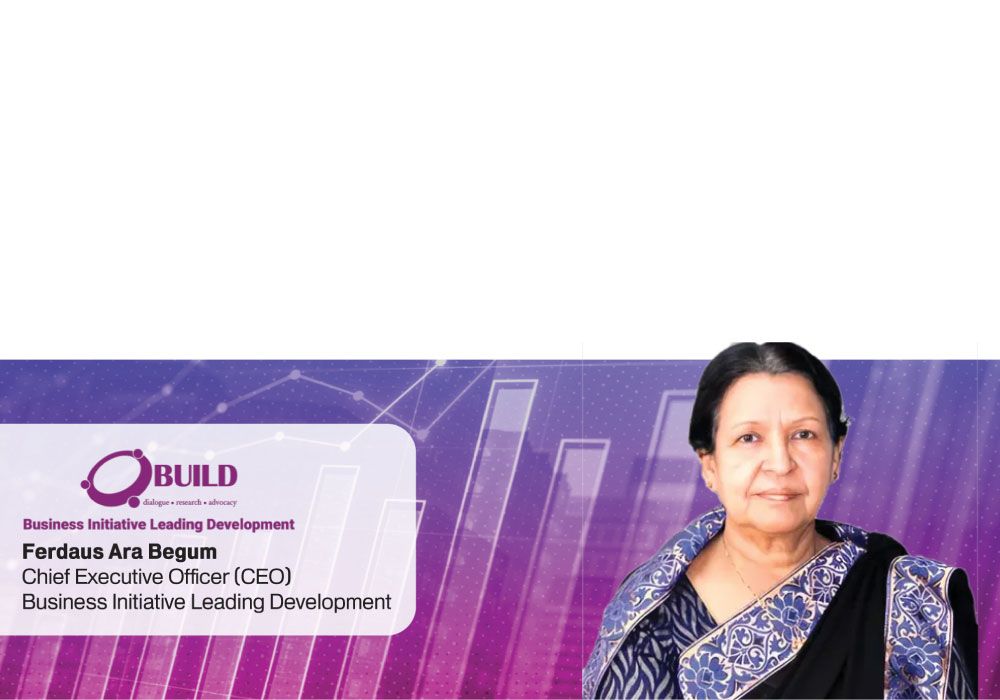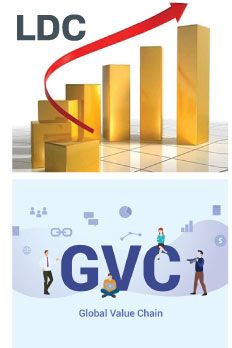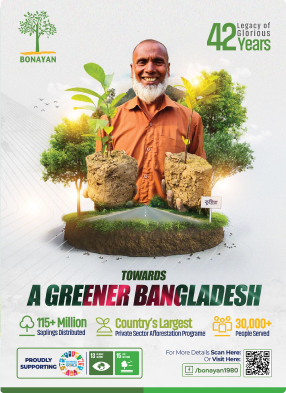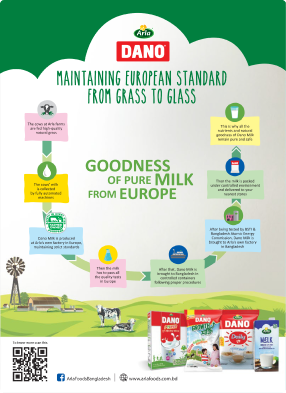- info@ficci.org.bd
- |
- +8802222271610, +8802222271611
- Contact Us
- |
- Become a Member
- |
- |
- |
- |
- |

Private investment has remained sluggish for a long time. Bangladesh plans for an ambitious investment target of at least 46.88% (private 36.36% and public 10.52%) by 2041, which is a huge amount. In the meantime, the Foreign Direct Investment (FDI) target is about 3% of GDP by this time.
In FY2022, we received an investment of only 25.90% from the private sector and 8.59% from the public sector for a total of about 34.49% or about $164.37 billion, including FDI of 1.70% of GDP.
By 2031, our GDP will be $1.07 trillion, and our investment target is 41.15% (private sector 31.43% + public sector 9.72% + FDI 3%), or $472 billion. We need a big push for a prolonged period to create an investment ecosystem so the private sector can come forward with their investment proposals.
Trade and patterns of private investment in the context of LDC graduation will face a lot of challenges because of the growing competition and erosion of several preferences. Public investment has been increasing for some infrastructural supportive projects to facilitate private investment; however, the private sector's need for both hard and soft infrastructure has not yet been fulfilled properly.

A recent study by the Economic Relations Division (ERD) has elaborated on some challenges faced by Small and Medium Enterprises (SMEs), investment and the FDI trend - which is mostly concentrated in a few sectors, such as power generation and apparel, and the eventual decrease of FDI because of the recent political tension.
The study also analysed the investment policies, challenges of private sector investment, the impact of international support measures (ISM) on the trade of Bangladesh, the decline of exports at 14%, threats for some sectoral issues, especially for RMG and Pharma, which have strong footholds in the local and foreign markets.
It also tried to analyse some economic data to understand the relationship between ISMS, private investment and export sectors using scatter plots - which have shown that goods exports are a significant predictor of both private investment and FDI.
Access to finance is another issue, while the repatriation of profit is a long-standing demand of the private sector. Recent income tax laws included a provision for the reopening of cases.
Loss of LDC exemption under the WTO agreement on subsidies and countervailing measures will be critical for the country. Direct export subsidies, such as cash incentives in about 46 product categories, need to be substituted for any other forms of non-actionable subsidies.
After LDC graduation, direct subsidies on export performance and local subsidies will be in question. This means that any measures that harm any other WTO members cannot be given. WTO-compatible export subsidies such as research subsidies like industrial research, assistance to the disadvantageous region, and adaptation of facilities for new environmental requirements will be considered non-actionable subsidies.
In 2019, cash incentives amounted to about 22.5% of government revenue, or about 3.7% of GDP. RMG, our biggest export sector, enjoys 2% cash incentives for exports to traditional markets (US, EU, Canada) and 4% for others, while it enjoys duty-free import of raw materials, Bonded Ware warehouse facilities, corporate tax benefits, etc. Patterns of supporting industries need to be changed to prepare for LDC graduation.
Loss of S&DT treatment under TRIPS will be another cause of concern after graduation. The pharmaceutical sector enjoys patent wavers, meaning Bangladeshi companies manufacture patented drugs without paying royalties.
What should be done for these sectors to sustain themselves after graduation? The Intellectual Property Act has been revisited. However, it did not include trade secrets, which could be helpful for small innovations.
Access to Development Assistance Financing, such as UN-LDC reserved services, will cease; the LDC Fund for Climate Change, the Technology Bank, and the Investment Support Programme will be reduced. Bangladesh needs to be prepared to face a changed situation.
RMG is going to face threats in the EU markets because of the  safeguard measures. Developing Countries Trading Schemes (DCTS) of the UK is liberal; under comprehensive preference (CP), the Rules of Origin (RoO) is 25% while it will be 50% under Enhanced Preference (EP). This means that after graduation, origin requirements will be doubled. Also, a double transformation will be required in the UK market for the apparel sector. Industry sectors are concerned about these issues and should prepare accordingly.
safeguard measures. Developing Countries Trading Schemes (DCTS) of the UK is liberal; under comprehensive preference (CP), the Rules of Origin (RoO) is 25% while it will be 50% under Enhanced Preference (EP). This means that after graduation, origin requirements will be doubled. Also, a double transformation will be required in the UK market for the apparel sector. Industry sectors are concerned about these issues and should prepare accordingly.
Investment-related policies would need to be updated to meet the present requirements. Foreign Private Investment Protection and Promotion Act (FPIPPA) of 1980, Industrial Policy, BSCIC Act, and many other policies need updates.
Ownership of land by foreign investors is also a point. Land tenure rules and the consolidation of legal rule regimes for legal transparency and predictability are also important.
Industrial Policy 2022 mentioned that import substitution would be encouraged (Chapt 12), but several studies raised the issue of anti-export bias and referred to the high tariff for protecting local industries. The average import tariff rate is 28.8% in Bangladesh, which is 9.6% in Thailand and Vietnam.
Bangladesh mostly exports finished products, while about 70% of trade in the world is in intermediate products. More and more FDI can be attracted if Bangladesh exports such products. It can help integrate the global value chain (GVC).
Ways forward
Some specific recommendations in respect of import substitution and export-led growth could help the Ministry of Industry (Mol) frame a new policy. In the Industrial Policy 2022, there is a mention of 22 controlled industries for which approvals have to be obtained, which is difficult. Also, a number of the sectors on the list included the trade and invest- ment-supportive services sector.
The governing body of Bangladesh Investment Development Authority (BIDA) could include representation from vital stakeholders such as the Ministry of Law, Justice, and Parliamentary Affairs, the Ministry of Road Transport and Bridges, the Ministry of Land, the National Board of Revenue (NBR), etc. The authority should include an LDC gradua- tion plan with a clear incentive package for private-sector investors.
There are 31 bilateral treaties signed by Bangladesh that are old and need updates. Accommodating changes in the country's status should be one of the top priorities. Otherwise, it could create problems.
The definition of microindustry and small industry in the manufacturing sector is different in the BSCIC Act 2023 and Industrial Policy 2022. Workers in the Industrial Policy refer to 1-25 workers as micro industries, while in the BSCIC Act, it is referred to as 16-30 workers. On the other hand, Industrial Policy 2022 defines small industries with employment of 26-120, while in the BSCIC Act, it is 31-120.
A time-bound action plan for the implementation of BSCIC Bill 2023 could be helpful. Workers' welfare is mentioned in the BSCIC Act (Chapter 5). However, the Labour Act has not been referred to in the act, so it means that the BSCIC Act itself should ensure the workers' welfare.
The lower number of required income tax return documents, from 29 to 12, is a good initiative. However, repatria- tion was a long-standing issue. The permissible limit of royalty, technical services fee, technical know-how fee, technical assistance fee, or any other expenditure of a similar nature is 10% of the net profit of the business or profession, excluding income or profit from the subsidiary, associate, or joint venture as shown in the financial statement.

Royalties, technical service fees, technical knowledge fees, TA fees or expenses of a similar nature shall be treated as fully admissible expenditures, taking into account the actual business expenses. The allowable limit shall be 6% of the turnover shown in the financial statements, in line with the foreign exchange guidelines and policies of BIDA.
Feasibility studies for FTA or PTAs with 23 countries have been completed; ongoing FTA discussions with 11 South- east Asian countries, a Comprehensive Economic Partnership Agreement (CEPA) with India, and the signing of a MOA with China are in the process.
Revenue-related issues came up while signing the FTA. The tax policy of the government now is to move away from dependency on indirect tax and put emphasis on direct tax. In that respect, we need to be serious about signing FTAs and EPAS to face the challenging situation of LDC graduation.
This Article was published on 14 January, 2024 at The Business Standard





